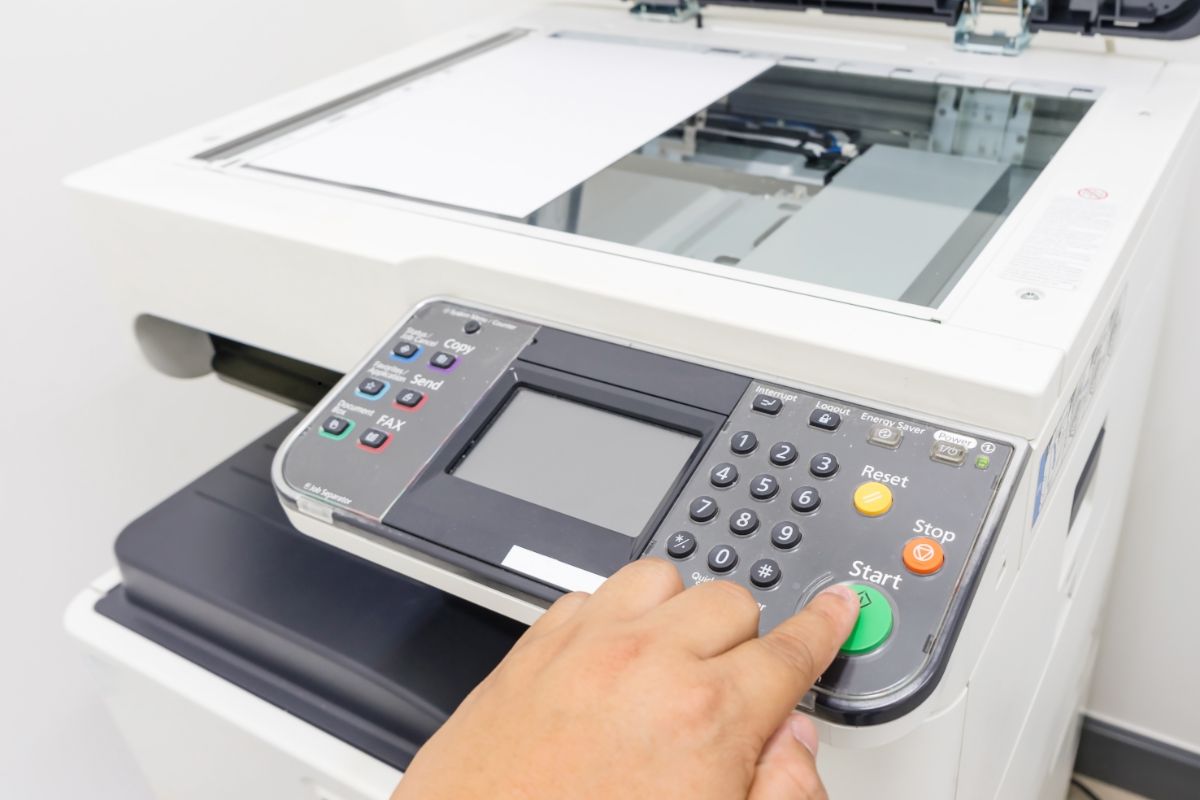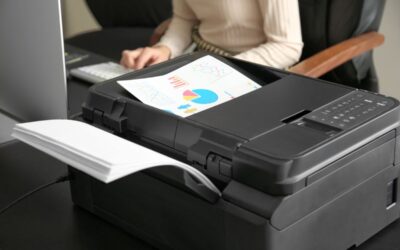Yet even top-tier machines experience problems from time to time. A solid grasp of troubleshooting techniques helps keep your office running smoothly and prevents costly repair calls.
1. Why Copier Troubleshooting Matters
When a copier malfunctions, it can disrupt the entire workflow. This can delay projects, affect productivity, and even impact client satisfaction. By identifying and addressing problems quickly, businesses can:
- Reduce downtime and keep operations moving.
- Avoid expensive emergency repair calls.
- Extend the lifespan of the copier.
- Improve print quality and consistency.
Troubleshooting is not just about fixing a problem when it occurs; it’s also about diagnosing underlying causes to prevent recurrence.
2. Common Copier Problems and Solutions
Below are the most frequent copier issues and how to address them.
Paper Jams
Symptoms: The Copier displays an error message or stops mid-print with crumpled, folded, or stuck paper inside.
Causes:
- Misaligned paper in the tray.
- Paper that is too thick or thin for the machine’s specifications.
- Worn feed rollers.
- Foreign objects in the paper path.
Troubleshooting Steps:
- Stop the machine immediately to avoid further damage.
- Open the paper path covers following the manufacturer’s instructions.
- Gently remove jammed paper without tearing it. If it tears, locate and remove all small pieces.
- Cleaning the rollers for dust or wear—clean with a lint-free cloth and mild cleaner if necessary.
- Reload paper correctly, ensuring the stack is aligned and within capacity limits.
Prevention Tip: Use the correct paper type and store it in a dry environment to prevent moisture absorption, which causes sticking.
Streaks, Lines, or Spots on Prints
Symptoms: Vertical or horizontal lines, smudges, or dots appear on copies and prints.
Causes:
- Dirt or residue on the scanner glass.
- Toner cartridge issues.
- Worn or damaged drum unit.
- Foreign particles inside the machine.
Troubleshooting Steps:
- Inspect the scanner glass and clean it with a microfiber cloth and glass cleaner.
- Print a test page—if the defect still exists, the issue may be in the print path.
- Check toner cartridges for leaks or damage; replace if necessary.
- Inspect the drum unit and replace it if worn.
Prevention Tip: Regularly clean the scanner glass and run copier maintenance cycles recommended by the manufacturer.
Poor Print Quality (Faded, Blurry, or Uneven)
Symptoms: Prints appear too light, fuzzy, or inconsistent.
Causes:
- Low toner levels.
- Incorrect print density settings.
- Humidity affects paper.
- Worn imaging components.
Troubleshooting Steps:
- Check toner levels and replace them if low.
- Adjust print density settings in the copier menu.
- Ensure paper is fresh and within the machine’s recommended specs.
- Run calibration or cleaning cycles through the copier’s maintenance menu.
Prevention Tip: Keep spare toner cartridges on hand and use paper recommended by the manufacturer.
Copier Won’t Turn On
Symptoms: No lights or response when pressing the power button.
Causes:
- Power cord disconnected.
- Faulty power outlet.
- Blown fuse or internal power supply issue.
Troubleshooting Steps:
- Check the power cord connection to the copier and the wall outlet.
- Test the outlet by plugging it into another device.
- Inspect for tripped breakers or blown fuses in the building’s electrical panel.
- If still unresponsive, contact a service technician—internal power supply repairs require professional handling.
Prevention Tip: Avoid connecting copiers to overloaded power strips. Use a dedicated outlet when possible.
Slow Printing or Copying
Symptoms: The Copier takes unusually long to start or complete jobs.
Causes:
- High-resolution settings are slowing down processing.
- Network congestion.
- Outdated firmware.
- Large print files.
Troubleshooting Steps:
- Lower resolution settings when high quality is not needed.
- Check the network connection—wired connections are generally faster than Wi-Fi.
- Update the copier firmware to the latest version.
- Break large print jobs into smaller batches.
Prevention Tip: Match print settings to the job requirements to balance speed and quality.
Connectivity Issues
Symptoms: The Copier cannot connect to a computer, network, or mobile device.
Causes:
- Incorrect network settings.
- Faulty cables or Wi-Fi interference.
- Outdated printer drivers.
Troubleshooting Steps:
- Verify network settings in the copier’s menu.
- Test Ethernet or USB cables for damage and replace if needed.
- Restart the copier, router, and computer to refresh connections.
- Reinstall or update printer drivers on connected devices.
Prevention Tip: Keep firmware and drivers updated to maintain compatibility with network protocols.
Error Codes
Symptoms: The Copier displays a specific alphanumeric error code.
Causes: Each code corresponds to a specific malfunction, such as overheating, toner sensor failure, or paper feed issues.
Troubleshooting Steps:
- Refer to the user manual or the manufacturer’s online database for code meanings.
- Follow the recommended steps to clear the error.
- If unresolved, contact a certified technician with the code for faster diagnosis.
Prevention Tip: Regular maintenance helps prevent recurring error codes.
3. General Troubleshooting Best Practices
Even though copiers vary by brand and model, certain troubleshooting principles apply across the board.
- Read the manual: Many typical problems are addressed in the manufacturer’s documentation.
- Follow safety precautions: Power off and unplug the machine before removing covers or accessing internal parts.
- Document issues: Keep a log of recurring problems, error codes, and repair dates for future reference.
- Avoid forcing components: Forcing paper out or jamming parts back into place can cause further damage.
4. Preventive Maintenance to Avoid Problems
The best troubleshooting is proactive—addressing potential issues before they cause downtime.
Scheduled Cleaning
- Dust and debris inside the copier can cause jams, streaks, and component wear.
- Use manufacturer-approved cleaning kits or schedule professional cleanings every few months.
Regular Inspections
- Check feed rollers, belts, and moving parts for wear.
- Inspect paper trays for cracks or misalignment.
Updating Firmware
- Manufacturers often update firmware to fix bugs, improve security, and enhance performance.
Using Quality Supplies
- Use OEM toner and compatible paper types to ensure the best performance and avoid voiding warranties.
5. When to Call a Professional
While many copier problems can be resolved in-house, some require trained technicians. Call for professional service if:
- The copier emits unusual noises or smells.
- The machine overheats or repeatedly shuts down.
- Error codes persist after basic troubleshooting.
- You suspect electrical or internal mechanical damage.
Certified technicians have the tools and training to diagnose and repair complex issues safely and efficiently.
6. Troubleshooting Copiers in Large Offices
For organizations with multiple copiers, troubleshooting involves an added layer of coordination:
- Designate “super users” trained in advanced copier functions and basic repairs.
- Centralize service records for all devices.
- Establish usage guidelines to prevent misuse, such as prohibiting non-approved paper types.
7. The Role of Managed Print Services (MPS)
Partnering with a Managed Print Services provider can drastically reduce copier downtime. MPS providers:
- Monitor devices remotely for early signs of problems.
- Perform routine maintenance on schedule.
- Provide automatic toner replenishment.
- Offer priority service calls for emergencies.
MPS is the most cost-effective way for many businesses to ensure copier reliability.
Copier Troubleshooting Tips for Offices in New England and Florida
A smoothly running copier at BDS is vital for your business’s productivity. Our experts quickly diagnose and resolve issues, from simple jams to complex hardware failures. As an authorized dealer for leading copier brands, we offer repairs, maintenance, and print services to reduce downtime.
We have local technicians in Massachusetts, Connecticut, Rhode Island, New Hampshire, Maine, Vermont, and Florida. They provide quick solutions to keep your office printing smoothly. Trust BDS to support your copier performance, whether you need troubleshooting, on-site repairs, or print management services.






